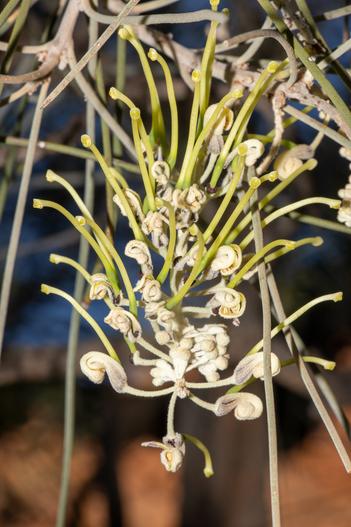Cork Tree
(Hakea suberea)
Cork Tree (Hakea suberea)
/
/

Tim Hammer
CC BY 4.0
Image By:
Tim Hammer
Recorded By:
Copyright:
CC BY 4.0
Copyright Notice:
Photo by: Tim Hammer | License Type: CC BY 4.0 | License URL: http://creativecommons.org/licenses/by/4.0/ | Occurence ID: https://www.gbif.org/occurrence/3881619410 | Publisher: Inaturalist |


Estimated Native Range
Summary
Hakea suberea, commonly known as Cork Tree, is an evergreen tree native to the open woodlands and scrublands of northern Australia. It typically grows to a height of 7-15 feet (2.1-4.6 meters) and a width of 5-10 feet (1.5-3 meters). The Cork Tree is characterized by its corky bark, which is thick and furrowed, providing a unique texture in the landscape. It produces small clusters of yellow, white, and green flowers during the fall and winter months, which are modest in appearance but can be quite attractive upon close inspection.
The Cork Tree is valued for its drought tolerance and adaptability to various soil types, making it a suitable choice for xeriscaping and low-water-use gardens. Its compact size allows it to be used in smaller gardens, as a specimen tree, or in mixed shrub borders. In cultivation, it requires full sun exposure to thrive and prefers well-drained soils, although it can tolerate a range of drainage conditions from slow to fast. Gardeners should be aware that Hakea species can be susceptible to root rot if overwatered or planted in poorly drained soils. Additionally, the Cork Tree’s woody seed capsules can be a point of interest, as they persist on the tree for long periods.CC BY-SA 4.0
The Cork Tree is valued for its drought tolerance and adaptability to various soil types, making it a suitable choice for xeriscaping and low-water-use gardens. Its compact size allows it to be used in smaller gardens, as a specimen tree, or in mixed shrub borders. In cultivation, it requires full sun exposure to thrive and prefers well-drained soils, although it can tolerate a range of drainage conditions from slow to fast. Gardeners should be aware that Hakea species can be susceptible to root rot if overwatered or planted in poorly drained soils. Additionally, the Cork Tree’s woody seed capsules can be a point of interest, as they persist on the tree for long periods.CC BY-SA 4.0
Plant Description
- Plant Type: Tree
- Height: 7-15 feet
- Width: 5-10 feet
- Growth Rate: Moderate
- Flower Color: Green, White, Yellow
- Flowering Season: Fall, Winter
- Leaf Retention: Evergreen
Growth Requirements
- Sun: Full Sun
- Water: Medium
- Drainage: Fast, Medium, Slow
Common Uses
Drought Tolerant, Low Maintenance
Natural Habitat
Native to open woodlands and scrublands of northern Australia
Other Names
Common Names: Bootlace Oak
Scientific Names: Hakea suberea , Hakea lorea subsp. lorea , Hakea cunninghamii , Grevillea lorea , Hakea lorea var. mollis
GBIF Accepted Name: Hakea lorea subsp. lorea